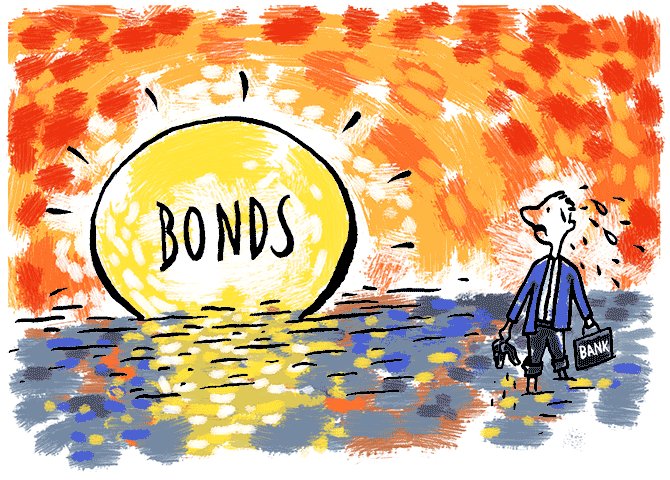'Banks, fund managers, NBFCs, rating agencies, those buying into debt funds -- all of them will have to watch their step as India's financial system enters a new phase,' warns T N Ninan.
Illustration: Dominic Xavier/Rediff.com

The Reserve Bank has given occasional voice to the concern that bank interest rates are not high enough to offer savers a return, over and above the rate of inflation (a 'real' rate of return).
This and the collapse of the housing market has led in recent times to more money flowing into mutual funds than ever before; much of the inflow has found its way to debt instruments that have given better returns than banks.
However, when it comes to credit, the situation is reversed: The banks charge higher rates because they have to cover large operational costs.
For instance, State Bank of India's best rate for a three-year loan is 8.1 per cent, whereas the comparable yield on the highest-rated bonds is just above 7 per cent.
Naturally, companies with strong balance sheets will move from banks to bonds in order to access cheaper finance.
That will leave the banks with having to lend more to companies that can't get good credit ratings -- which is another way of saying that the quality of bank credit will suffer.
Given the already high level of stressed banking assets, this presents a renewed challenge.
The gap between bank lending rates and bond yields is not new, but it didn't matter in the past because restrictive rules for the bond market limited its size.
More recently, bond market volumes have been growing rapidly, and a 'Mint Street Memo' posted last month on the Reserve Bank Web site put its finger on the transition point: 2016-17.
In most years banks accounted for more than half the total flow of funds to the commercial sector.
But in 2016-17 the share of bank funds dropped to a low point of 38.4 per cent from 52.3 per cent the previous year.
This situation is unlikely to have been reversed in the current financial year, given many banks' shortage of capital.
The problem of losing their best customers is particularly acute for the weaker banks that already face issues of credit quality and interest-rate spread.
A shake-out in the banking sector seems inevitable, and is already under way.
The development of non-bank sources of funds is not a bad thing. Indeed, it has been a point of criticism for many years that the country's financial system is unusually bank-centric, and that the bond market needs to be developed -- as in the developed financial markets elsewhere.
If they lose their best commercial customers, banks seeking to improve their balance sheets would be forced to focus on relatively safe retail lending (for housing, cars and the like), or on working capital loans that are backed by receivables.
The problem in India is that, in the absence of a strong second tier of financial intermediaries -- non-banking financial companies (NBFCs) that can operate more flexibly than banks -- customers in the small and medium sector would find their credit needs not being met.
The new situation puts the spotlight on another set of players: The credit rating agencies. It is their rating of corporate bonds that influences bond yields.
Typically, debt mutual funds that buy bonds manage to offer relatively attractive yields only by mixing up the better-rated paper with other instruments that have poorer ratings.
Given the way salesmen anywhere function, the precise nature of this mix may or may not be fully disclosed to customers, or fully understood.
That makes it even more critical that the rating exercise is of the highest quality; after all, rating failure was one of the main causes of the Western financial meltdown of 2008.
In India too, there have been cases of companies with reassuringly good ratings going belly up at startling speed.
While these have been only a few so far, the fact is that most retail customers rushing with their money to the bond market are less than fully aware that the better yields come bundled with greater risk.
Banks, fund managers, NBFCs, rating agencies, those buying into debt funds -- all of them will have to watch their step as India's financial system enters a new phase.









